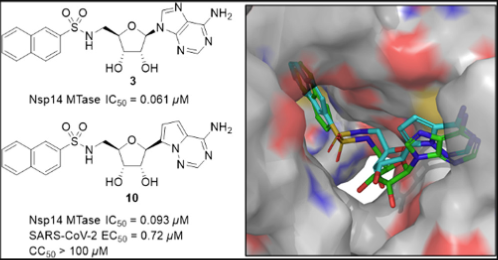Bisubstrate inhibitors for treating SARS-CoV-2 infections
Bisubstrate inhibitors that target the active site of SARS-CoV-2 Nsp14 methyltransferase (MTase) for treating SARS-CoV-2 infections.

Applications
- COVID-19 treatment
- Research tool
Key Benefits & Differentiators
- Effective SARS-CoV-2 infection treatment: These inhibitors demonstrate potent antiviral activity against SARS-CoV-2, potentially reducing the severity and duration of the virus.
- Attractive drug target: MTase is essential for virus viability and is less susceptible to mutational changes.
- Selective Antiviral Action: These inhibitors exhibit selectivity by specifically targeting the viral MTase enzyme, minimizing the risk of adverse side effects or harm to human cells.
- Low Cytotoxicity: Compound 10 exhibits high antiviral activity and low cytotoxicity, leading to a therapeutic index (CC50/EC50) greater than 139.
Technology Overview
While the availability of vaccines, antibodies, and antiviral drugs helped to end the COVID-19 pandemic, the recent emergence and rapid spread of more infectious variants of severe acute respiratory syndrome coronavirus 2 (SARS-CoV-2) call for continued efforts to develop effective therapeutics to combat the virus. The emergence of SARS-CoV-2 variants results from rapid genetic mutations of the virus due to replication errors, cellular pressure, and exposure to populations with varying immunity levels. These events have led to SARS-CoV-2 variants that are resistant to currently available treatments. New treatments that are not susceptible to the drug resistance mechanisms of these variants are urgently needed to combat SARS-CoV-2 infections and to help prevent future coronavirus pandemics.
Researchers at the University of Minnesota have developed bisubstrate inhibitors designed to target the narrow active site of SARS-CoV-2 Nsp14 MTase. Nsp14 MTase is an attractive drug target because the enzyme is essential for viability and is less susceptible to mutational changes. These inhibitors simultaneously engage with SAM and RNA substrate binding pockets, delivering potent antiviral efficacy with maintained selectivity and minimal cytotoxicity. Compounds 3 and 10, the lead compounds from design and optimization efforts, exhibit potency with IC50 values in the nanomolar range. As a prototypic inhibitor, compound 3 also has an excellent selectivity profile over a panel of human MTases. Compound 10, a C-nucleoside derivative, exhibits high antiviral activity and low cytotoxicity, leading to a high therapeutic index. Furthermore, a brief metabolic profiling of these two compounds suggests that they are less likely to suffer from major metabolic liabilities. Moreover, computational docking studies point to protein−ligand interactions that can be exploited to enhance inhibitory activity. In summary, the development of these inhibitors marks a significant milestone in finding new therapeutic compounds for combating coronavirus infections.
Phase of Development
TRL: 3-4In vitro and antiviral data have been collected for compound 3 and 10. Further chemical modifications of the lead compound have been initiated.
Desired Partnerships
This technology is now available for:- License
- Sponsored research
- Co-development
Please contact our office to share your business’ needs and learn more.
Researchers
- Liqiang Chen, PhD Associate Professor, Center for Drug Design
- Robert J. Geraghty, PhD Professor, Center for Drug Design
-
expand_more library_books References (1)
- Eunkyung Jung, Ruben Soto-Acosta, Jiashu Xie, Daniel J. Wilson, Christine D. Dreis, Ryuichi Majima, Tiffany C. Edwards, Robert J. Geraghty, and Liqiang Chen (2022), Bisubstrate Inhibitors of Severe Acute Respiratory Syndrome Coronavirus‑2 Nsp14 Methyltransferase, ACS Medicinal Chemistry Letters, 13 (9), 1477-1484
-
expand_more cloud_download Supporting documents (1)Product brochureBisubstrate inhibitors for treating SARS-CoV-2 infections.pdf